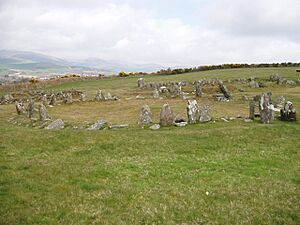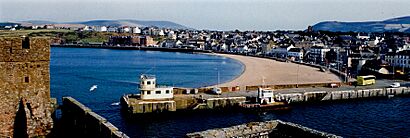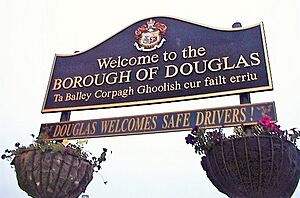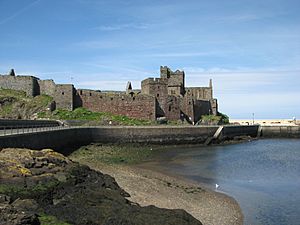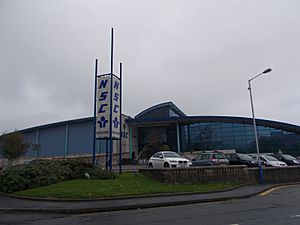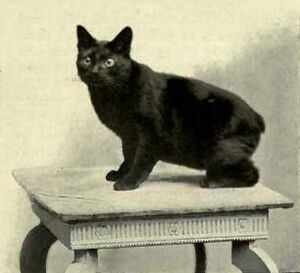Isle of Man facts for kids
Quick facts for kids
Isle of Man
|
|||
|---|---|---|---|
|
British Crown Dependency
|
|||
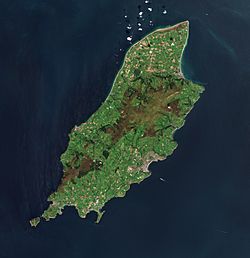 |
|||
|
|||
| Motto: | |||
| Anthem: "O Land of Our Birth" | |||
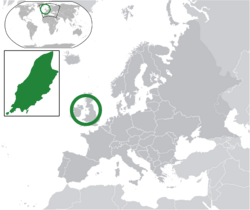
Location of the Isle of Man (green), in Europe (dark grey)
|
|||
| Sovereign state responsible for the Isle of Man | United Kingdom | ||
| Norse control | 9th century | ||
| Scottish control | 2 July 1266 | ||
| English control | 1399 | ||
| Revested into British Crown | 10 May 1765 | ||
| Capital | Douglas 54°09′N 4°29′W / 54.15°N 4.48°W |
||
| Official languages | |||
| Ethnic groups
(2021)
|
|||
| Religion
(2021)
|
|
||
| Demonym(s) | Manx | ||
| Government | Parliamentary democratic constitutional monarchy | ||
| Charles III | |||
| Sir John Lorimer | |||
| Alfred Cannan | |||
| Legislature | Tynwald | ||
| Legislative Council | |||
| House of Keys | |||
| Area | |||
|
• Total
|
574 km2 (222 sq mi) (unranked) | ||
|
• Water (%)
|
1 | ||
| Highest elevation | 2,030 ft (620 m) | ||
| Population | |||
|
• 2021 census
|
84,069 (202nd) | ||
|
• Density
|
148/km2 (383.3/sq mi) (86th) | ||
| GDP (PPP) | 2014 estimate | ||
|
• Total
|
$7.43 billion | ||
|
• Per capita
|
$84,600 (9th) | ||
| GDP (nominal) | estimate | ||
|
• Total
|
US$7.49 billion | ||
| HDI (2010) | 0.849 very high · 14th |
||
| Currency | Pound sterling Manx pound (£) (GBP) |
||
| Time zone | UTC±00:00 (GMT) | ||
|
• Summer (DST)
|
UTC+01:00 (BST) | ||
| Date format | dd/mm/yyyy | ||
| Mains electricity | 240 V, 50 Hz | ||
| Driving side | left | ||
| Calling code | +44 | ||
| UK postcode |
IM1 – IM99
|
||
| ISO 3166 code | IM | ||
| Internet TLD | .im | ||
The Isle of Man (Manx: Mannin or Ellan Vannin), also called Mann, is a special island. It is a self-governing British Crown Dependency located in the Irish Sea. You can find it between Great Britain and Ireland. The Isle of Man is known as one of the Celtic nations and is home to the Manx people, who are a Celtic group.
King Charles III is the head of state, holding the title Lord of Mann. He is represented on the island by a Lieutenant Governor. The government of the United Kingdom helps with the island's military defense and represents it in other countries.
People have lived on the island for a very long time, since before 6500 BC. In the 5th century AD, Irish missionaries brought Gaelic culture. This is when the Manx language started to develop. Later, in the 9th century, Norsemen (Vikings) took control and formed the Kingdom of the Isles, which included the Isle of Man.
In 1266, the King of Norway sold the island to the King of Scotland. After some time under both Scottish and English rule, the island became part of the English Crown in 1399. In 1765, it officially became part of the British Crown. However, the Isle of Man has always managed its own internal government. In 1881, the island's parliament, Tynwald, was the first national law-making body to let women vote in a general election.
The Isle of Man is famous for the TT Motorcycle Races and the Manx cat, a special cat breed with short or no tails. In 2016, UNESCO recognized the Isle of Man as a biosphere reserve. This means it's a special place for nature and people to live together.
Contents
What's in a Name?
The Manx name for the Isle of Man is Ellan Vannin. Ellan means "island" in Manx. Vannin comes from Mannin, which is the Manx word for "Mann". So, Ellan Vannin means "Island of Mann". In English, the short name is either Mann or Man.
Ancient records show the name as Manu or Mana. The name is likely related to a Celtic word for 'mountain'. This is similar to the Welsh word mynydd for mountain.
The island's name might also be linked to Manannán mac Lir. He is a sea god from Irish mythology. Some stories say he was a famous merchant who gave the island its name.
A Journey Through History
The Isle of Man became separated from other islands around 8000 BC. This happened when sea levels rose after the last ice age. Humans first came to the island by boat before 6500 BC. These early people were hunter-gatherers and fishermen. You can see their tools at the Manx Museum.
Early Settlements
During the Neolithic Period, people started farming. They also built large stone monuments called megalithic monuments. Examples include Cashtal yn Ard and King Orry's Grave.
In the Bronze Age, burial mounds became smaller. People placed bodies in stone-lined graves with decorated pots. These mounds served as lasting markers across the land.
The ancient Romans knew the island as Insula Manavia. The Romans controlled the Irish Sea for four centuries. They used it to transport food from farms to their settlements. Few Roman items have been found on Man. This suggests the island was not very important to them.
Around the 5th century AD, many people moved from Ireland. This led to the island becoming more Gaelic. Ogham writing appeared, and the Manx language developed. It is a Goidelic language, similar to Irish and Scottish Gaelic.
In the 7th century, the island was controlled by the Anglo-Saxon King Edwin of Northumbria. He even launched raids from Man into Ireland. We don't know how much influence the Northumbrians had. Very few place names on the island come from Old English.
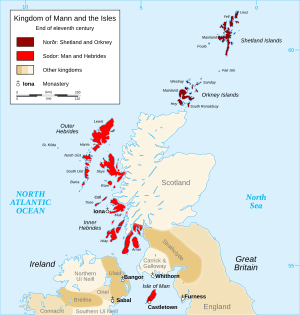
Viking and Scottish Rule
Vikings arrived in the late 700s. They created Tynwald, which is the island's parliament. They also set up many land divisions that are still used today. In 1266, King Magnus VI of Norway gave the islands to Alexander III, King of Scots. This was part of the Treaty of Perth. However, Scotland didn't fully control Man until 1275. This was after the Manx people were defeated in the Battle of Ronaldsway.
In 1290, King Edward I of England took control of Man. It stayed in English hands until 1313. Then, Robert the Bruce captured it after a five-week siege of Castle Rushen. Control of the island went back and forth between England and Scotland for some years. England finally took it for good in 1346.
The English Crown let different lords rule the island. Tynwald made laws for the island. It also controlled its money. But the Lord of Mann had to approve everything.
Modern Times
In 1765, the British Crown bought back the rights to the island. This was called the Act of Revestment. In 1866, the Isle of Man gained some self-rule. The House of Keys had partly democratic elections. Over time, the government became more democratic.
Today, the island's economy is strong. It benefits from its own tax rules. This has attracted wealthy people and businesses. The Isle of Man has over 250 historic sites. These are called registered buildings.
Exploring the Geography

The Isle of Man is an island in the middle of the northern Irish Sea. It's almost the same distance from England, Northern Ireland, and Scotland. It is about 52 kilometers (32 miles) long. At its widest, it is 22 kilometers (14 miles) wide. The island covers an area of about 572 square kilometers (221 square miles).
Besides the main island, there are smaller islands nearby. These include the Calf of Man, which is inhabited seasonally. There's also Chicken Rock, which has a lighthouse. St Patrick's Isle and St Michael's Isle are connected to the main island by roads.
Island Landscape
The island has hills in the north and south. A valley separates these two hill ranges. The northern part of the island is quite flat. It is mostly made of deposits from glaciers. At the very north, at the Point of Ayre, there are beaches made of small stones.
The highest mountain on the island is Snaefell. It is 620 meters (2,034 feet) tall. An old saying says you can see six kingdoms from its top: Man, Scotland, England, Ireland, Wales, and Heaven. Some people add a seventh kingdom: the sea.
What's the Weather Like?
The Isle of Man has a mild temperate oceanic climate. This means it has cool summers and mild winters. It gets more rain than the average for the British Isles. This is because it's far enough from Ireland for winds to pick up moisture.
The most rain falls on Snaefell, about 1,900 mm (75 inches) a year. In lower areas, it's around 800 mm (31 inches) a year. The island is sunnier than Ireland or most of England. It gets about 1,651 hours of sunshine each year. The highest temperature ever recorded was 28.9°C (84.0°F) in 1983. Because the Irish Sea keeps temperatures steady, it rarely freezes.
In 2019, the Isle of Man Government said it recognizes that climate change is a serious threat.
| Climate data for Ronaldsway, Isle of Man (1991–2020) | |||||||||||||
|---|---|---|---|---|---|---|---|---|---|---|---|---|---|
| Month | Jan | Feb | Mar | Apr | May | Jun | Jul | Aug | Sep | Oct | Nov | Dec | Year |
| Record high °C (°F) | 13.3 (55.9) |
13.2 (55.8) |
17.1 (62.8) |
20.0 (68.0) |
24.0 (75.2) |
27.5 (81.5) |
28.9 (84.0) |
27.8 (82.0) |
26.5 (79.7) |
22.7 (72.9) |
16.3 (61.3) |
15.0 (59.0) |
29.0 (84.2) |
| Mean maximum °C (°F) | 11.5 (52.7) |
11.2 (52.2) |
12.7 (54.9) |
15.7 (60.3) |
20.0 (68.0) |
21.8 (71.2) |
23.0 (73.4) |
21.3 (70.3) |
20.0 (68.0) |
17.1 (62.8) |
14.2 (57.6) |
12.4 (54.3) |
24.2 (75.6) |
| Mean daily maximum °C (°F) | 8.5 (47.3) |
8.4 (47.1) |
9.4 (48.9) |
11.5 (52.7) |
14.3 (57.7) |
16.5 (61.7) |
18.2 (64.8) |
18.2 (64.8) |
16.6 (61.9) |
13.8 (56.8) |
11.1 (52.0) |
9.2 (48.6) |
13.0 (55.4) |
| Daily mean °C (°F) | 6.4 (43.5) |
6.2 (43.2) |
7.0 (44.6) |
8.7 (47.7) |
11.2 (52.2) |
13.6 (56.5) |
15.4 (59.7) |
15.5 (59.9) |
14.0 (57.2) |
11.5 (52.7) |
8.9 (48.0) |
7.1 (44.8) |
10.5 (50.8) |
| Mean daily minimum °C (°F) | 4.3 (39.7) |
3.9 (39.0) |
4.5 (40.1) |
5.8 (42.4) |
8.1 (46.6) |
10.6 (51.1) |
12.5 (54.5) |
12.7 (54.9) |
11.4 (52.5) |
9.2 (48.6) |
6.7 (44.1) |
4.9 (40.8) |
7.9 (46.2) |
| Mean minimum °C (°F) | −0.9 (30.4) |
−0.8 (30.6) |
−0.2 (31.6) |
1.1 (34.0) |
3.4 (38.1) |
6.5 (43.7) |
8.9 (48.0) |
8.4 (47.1) |
6.6 (43.9) |
3.6 (38.5) |
1.0 (33.8) |
−0.7 (30.7) |
−2.3 (27.9) |
| Record low °C (°F) | −7.8 (18.0) |
−5.8 (21.6) |
−6.0 (21.2) |
−3.4 (25.9) |
−0.8 (30.6) |
1.4 (34.5) |
5.3 (41.5) |
4.9 (40.8) |
1.0 (33.8) |
−1.5 (29.3) |
−4.0 (24.8) |
−7.0 (19.4) |
−7.8 (18.0) |
| Average precipitation mm (inches) | 82.5 (3.25) |
65.5 (2.58) |
62.5 (2.46) |
55.1 (2.17) |
54.6 (2.15) |
62.4 (2.46) |
59.1 (2.33) |
67.4 (2.65) |
70.6 (2.78) |
103.3 (4.07) |
105.2 (4.14) |
95.0 (3.74) |
883.2 (34.78) |
| Average rainy days (≥ 1.0 mm) | 14.2 | 11.4 | 10.9 | 10.0 | 9.8 | 9.3 | 10.2 | 10.8 | 11.2 | 13.4 | 15.8 | 14.7 | 141.7 |
| Mean monthly sunshine hours | 54.6 | 82.8 | 127.3 | 181.9 | 235.3 | 213.4 | 203.5 | 190.2 | 145.9 | 105.4 | 63.9 | 47.0 | 1,651.2 |
| Source 1: Met Office | |||||||||||||
| Source 2: Météo Climat, Infoclimat | |||||||||||||
How the Island is Governed
The United Kingdom is in charge of the island's defense. It also helps represent the island in international matters. However, the Isle of Man's own parliament and government handle all local issues.
Island's Government Structure
The island's parliament is called Tynwald. Some people say it has been around since 979 AD. This would make it the oldest continuously running government in the world. Tynwald has two main parts:
- The House of Keys: Members are directly elected by people aged 16 and over.
- The Legislative Council: Members are chosen in other ways.
These two groups also meet together as the Tynwald Court.
The main government body is the Council of Ministers. It is made up of Tynwald members. The Chief Minister leads this council.
The Lieutenant Governor acts as the head of state.
International Connections
The Isle of Man is not part of the United Kingdom. But the UK handles its defense and foreign affairs. The UK can also make laws for the island. In 2007, the Isle of Man and the UK made an agreement. This agreement helps the Isle of Man develop its own international identity.
There is no separate Manx citizenship. People from the Isle of Man are British citizens. They can get a British passport. The Isle of Man Passport Office issues these passports.
The Isle of Man has strong ties with Ireland. The historic Manx language is similar to Irish and Scottish Gaelic. In 1947, the Irish leader Éamon de Valera helped save the Manx language.
Defense
The UK is responsible for the Isle of Man's defense. The island does not have its own military forces.
European Union
The Isle of Man was never part of the European Union (EU). It did not vote in the 2016 Brexit referendum. However, it was part of the EU's customs area. This meant Manx goods could be traded in the EU without extra taxes.
The island was not part of the EU's single market. There were limits on moving money, services, and workers. After Brexit, the island's relationship with the EU depends on the UK's agreement with the EU.
Commonwealth of Nations
The Isle of Man is not a full member of the Commonwealth of Nations. But it takes part in some Commonwealth groups. These include the Commonwealth Parliamentary Association and the Commonwealth Games. The Isle of Man government wants a closer relationship with the Commonwealth. They want more direct representation.
Island's Economy
The Isle of Man has a special tax system. It has no capital gains tax, wealth tax, stamp duty, or inheritance tax. The highest income tax rate is 20%.
The biggest parts of the economy are insurance and online casino operations. Each makes up 17% of the island's income. Technology and banking each contribute 9%. The most jobs are in healthcare, financial services, construction, and retail. Manufacturing, especially aerospace and food, employs almost 2,000 people. It makes up about 5% of the island's GDP. This sector produces laser optics, industrial diamonds, and electronics.
Tourism, farming, and fishing used to be very important. Now, they contribute less to the economy. The unemployment rate on the island is very low, less than 1%.
Most trade happens with the United Kingdom. The island shares customs revenues with the UK. This is part of the Common Purse Agreement.
Discovering Manx Culture
The Manx are a Celtic nation. The culture of the Isle of Man is shaped by its Celtic and Norse roots. Being close to the UK has also influenced its culture.
There have been efforts to bring back Manx culture. People are now more interested in the Manx language, history, and music.
Language of the Island
| Person | Manxie; Manxman, -woman (Manninagh) |
|---|---|
| People | Manx (Manninee) |
| Language | Manx (Manninish; Gaelg, Gailck; Ghlare Vanninagh) BSL (Glare Chowree) |
| Country | Isle of Man (Mannin, Ellan Vannin) |
The official languages are English and Manx. Manx was once "critically endangered," meaning very few people spoke it. But now, more young people are learning it. You can see Manx on public signs. It is also used more in the Tynwald ceremony.
Manx is a Goidelic Celtic language. It is related to Irish and Scottish Gaelic. The UK has officially recognized Manx as a regional language.
You might hear Manx greetings like moghrey mie (good morning) and fastyr mie (good afternoon). Another common phrase is traa dy liooar, meaning "time enough." This phrase shows a relaxed attitude to life.
In the 2011 census, about 1,800 residents said they could read, write, and speak Manx.
Island Symbols
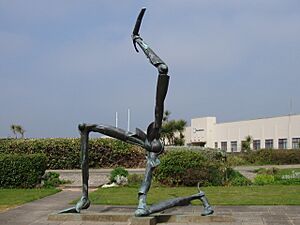
For centuries, the island's symbol has been the "three legs of Man." This is a triskelion with three legs joined at the thigh. It has been used since the late 13th century. Some think it came from Sicily, which also uses a triskelion.
The symbol is on the island's flag and coat of arms. It is also on its money. The island's motto is Quocunque jeceris stabit. This Latin phrase means "whichever way you throw, it will stand." It appeared on coins in the late 1600s. It might refer to a Caltrop, a military tool that always lands with one spike up.
The ragwort, or cushag, is considered the Manx national flower.
Myths and Legends
In Manx stories, the sea god Manannán ruled the island. He would cover it in mist to protect it from enemies. Many believe the island is named after him.
Manx folklore has many tales of mythical creatures:
- The Buggane: A mean spirit that supposedly blew the roof off a church.
- The Fenodyree: A hairy, helpful creature.
- The Glashtyn: A water horse.
- The Moddey Dhoo: A ghostly black dog at Peel Castle.
The Isle of Man is also said to be home to fairies. They are known as "the little folk." There is a famous Fairy Bridge. It's considered bad luck if you don't wish the fairies good morning or afternoon when you cross it. People used to leave a coin on the bridge for good luck.
An old Irish story says that Lough Neagh was formed when a giant threw a piece of land at a rival. He missed, and the land landed in the Irish Sea, creating the island.
Music and Arts
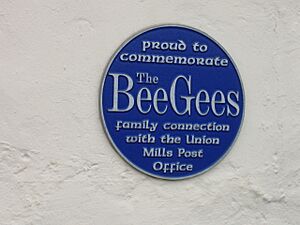
The music of the Isle of Man mixes Celtic, Norse, and other influences. These come from its neighbors like Scotland, Ireland, and England. You can hear many types of music on the island, including rock, blues, and jazz.
Traditional folk music has become popular again since the 1970s. This started with a music festival called Yn Chruinnaght. This revival happened after the last native Manx speaker passed away in 1974.
Composer Haydn Wood grew up on the Isle of Man. The island's folk tunes inspired his music. He wrote pieces like Manx Rhapsody and Mannin Veen (Manx for "Dear Isle of Man").
Delicious Manx Food
In the past, a common dish was spuds and herrin. This was boiled potatoes and herring. It was a simple meal for the island's farmers and fishermen. Today, "chips, cheese and gravy" is a popular fast-food dish. It's like poutine, with thick-cut fries, shredded cheese, and gravy.
Recently, queen scallops (queenies) were named the Manx national dish. Many restaurants serve these local scallops.
Seafood is a big part of the local diet. Manx kippers (smoked herrings) are a famous local food. They are made in Peel. Crab, lobster, and scallops are also fished. The queen scallop is a special treat.
Farmers raise cattle, sheep, pigs, and poultry. Manx lamb from the hill farms is very popular. The Manx Loaghtan sheep is a native breed. It has dark brown wool and often four or six horns. Its meat is considered a delicacy.
Manx cheese is also well-known. It comes in smoked and herb flavors. It is sold in many UK supermarkets.
Beer is brewed on the island by several breweries. The Isle of Man has a "Pure Beer Act" from 1874. It says brewers can only use water, malt, sugar, and hops.
Sports and Activities
The Isle of Man competes as a nation in the Commonwealth Games and the Island Games. It hosted the IV Commonwealth Youth Games in 2011. Manx athletes have won three gold medals at the Commonwealth Games. Cyclist Mark Cavendish won one in 2006. The Island Games were held on the island in 1985 and 2001. F.C. Isle of Man is a football team founded in 2019.
People on the Isle of Man enjoy many sports. These include rugby union, football, gymnastics, and cricket. Since it's an island, many watersports are also popular.
Motorcycle Racing
The most famous event on the island is the Isle of Man Tourist Trophy motorcycle race. It started in 1907. The TT is an international road racing event. It is considered one of the "greatest motorcycle sporting events in the world." The race takes place over two weeks in late May and early June. It's a big festival for motorcycling and helps the island's economy a lot. The Isle of Man is often called the "road racing capital of the world."
The Manx Grand Prix is another motorcycle event. It's for amateur riders and uses the same 60.70 km (37.72 mi) Snaefell Mountain Course. This race happens in late August and early September.
Traditional Sports
Cammag
Before football became popular, cammag was the island's traditional sport. It is similar to Irish hurling and Scottish shinty. Today, there is an annual cammag match in St John's.
Theatre and Cinema
The Gaiety Theatre and Opera House was built in 1899. It is located on the Douglas Promenade. It hosts plays, musicals, concerts, and comedy shows all year. The Broadway Cinema is part of the Gaiety Theatre Complex.
The Palace Cinema has two screens. Screen One holds 293 people, and Screen Two holds 95. It was updated in 2011.
Amazing Animals of the Isle of Man
Two special domestic animals are linked to the Isle of Man.
The Manx cat is a breed known for its short or missing tail. The tail can be very short ("stumpy") or completely gone ("rumpy"). Manx cats come in many colors. They usually have slightly longer back legs than other cats. Manx cats have been used as a symbol on the island's coins and stamps.
The Manx Loaghtan sheep is a native breed. It has dark brown wool and often four, or sometimes six, horns. Its meat is considered a special food. There are several flocks on the island.
A newer animal on the island is the red-necked wallaby. These wallabies now live freely on the island after escaping from a wildlife park. The police sometimes get calls about them.
There are also many wild goats in Garff.
In March 2016, the Isle of Man became the first entire territory to join UNESCO's Network of Biosphere Reserves. This means the whole island is recognized for its special natural and cultural environment.
People of the Isle of Man
Population and Census
In 2021, the Isle of Man had 84,069 people. Of these, 26,677 lived in the capital city, Douglas. The population grew by 755 people between 2016 and 2021.
The Isle of Man conducts its own census. It happens every ten years since 1821. There are also smaller censuses in between. It is similar to the Census in the United Kingdom.
Age Groups
- 0–14 years: 16.27%
- 15–24 years: 11.3%
- 25–54 years: 38.48%
- 55–64 years: 13.34%
- 65 years and over: 20.6% (2018 estimate)
Population Density
There are about 131 people per square kilometer (339 people per square mile) on the island (2005 estimate).
Gender Ratio
| Age range | Ratio |
|---|---|
| At birth | 1.08 |
| 0–14 | 1.09 |
| 15–24 | 1.13 |
| 25–54 | 1.00 |
| 55–64 | 1.02 |
| 65+ | 0.89 |
| Total population | 1 (2020 estimate) |
Ethnic Backgrounds
- White: 94.7%
- Asian: 3.1%
- Black: 0.6%
- Other: 0.6%
- Mixed: 1.0%
Religions
- Christianity: 54.7%
- No religion: 43.8%
- Buddhism: 0.5%
- Islam: 0.5%
- Hinduism: 0.4%
- Judaism: 0.2%
Images for kids
See Also
 In Spanish: Isla de Man para niños
In Spanish: Isla de Man para niños
- History of the Isle of Man
- Outline of the Isle of Man
- List of places in the Isle of Man
- United Kingdom–Crown Dependencies Customs Union
- Public holidays in the Isle of Man




